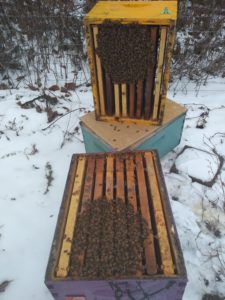What are your bees doing right now? If you’re in a northern location like me in Michigan the answer for most of the period between November and February may be not much. . . but they aren’t doing nothing. They are dormant but they aren’t hibernating. During the period of winter dormancy the bees will cluster together to conserve the heat generated by individual bees vibrating their flight muscles. The bees aren’t attempting to heat the entire volume of the hive like we would heat a house, instead their shivering behavior just maintains the necessary temperature of the cluster itself. This behavior allows the colony to survive very cold external temperatures and generate enough heat to begin brood rearing which typically starts shortly after the winter solstice.
When I mention ‘my bees’ I’m referring to the Sentinel Apiary I manage in Leelanau County. I was out in mid-December on a 40ish degree day to take advantage of their broodless period and apply an Oxalic acid dribble as part of my Varroa mite management strategy. This brief cracking of the hives provided a chance to assess cluster size and position as well as evaluate stores. It’s not optimal to be opening hives this time of year and you certainly shouldn’t be pulling frames but I deliberately picked a fairly mild day with minimal wind for the time of year. Overall the colony was open for about 20 seconds and I was able to assess the condition and apply the Oxalic Acid with minimum disturbance.
I was relatively pleased with the size of cluster shown below, a little bigger would be ideal but they appear to be of adequate size to have a strong chance of surviving winter. They happened to be vertically centered near the top bars of the bottom box (purple) so the view is of the roughly spherical cluster split at the equator. The middle box (yellow tipped on end) had very good weight to it and the top box (blue with inner cover and moisture board remaining in place) was a box full of capped honey. This should be plenty of honey to get them through to April when the first dribble of nectar appears and it is starting to get warm enough for them to take liquid feed.

If I had found them primarily in the middle box or up into the top at this early stage of winter I would be more concerned about their stores and be making plans to get some fondant on as an emergency feed to get them through the later stages of winter but they still have plenty of food to eat their way up into. If you find your bees are high in the hive early in winter or getting light while spring nectar or syrup is still a ways off providing the colony with fondant is your best chance to avert starvation. Fondant is relatively easy to make, a couple recipes are available here and here. It’s certainly isn’t a sure thing that this colony survives the winter but I’m fairly optimistic given the aggressive Varroa control through the season to keep mites and viruses in check and adequate food stores above these bees.